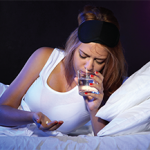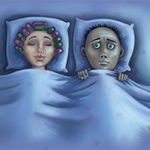The Eyes Have It
Light is the strongest and most important environmental timing clue and in mammals can only be perceived by the eyes. A morning blast of strong light can spring us up and out of bed, but at night it can interfere with our ability to fall asleep. When light passes through our eyes, a selective group of recently identified photosensitive ganglion cells initiates the process of signal transfer to the suprachiasmatic nucleus. Exposure to bright daytime light enhances nocturnal secretion of melatonin, the primary product of the pineal gland and a key molecule for inducing sleep.
Besides inducing somnolence, melatonin has potent antioxidant effects and it has been suggested that it may have anticancer properties. The ‘‘melatonin hypothesis’’ postulates that light at night as opposed to daytime exposure, may be an important factor in explaining the higher cancer risks found in industrialized countries. In fact, in 2007, the World Health Organization (WHO) declared shift work to be a probable carcinogen. Since melatonin levels are naturally higher in blind persons, what is their cancer incidence? Indeed, the incidence of most types of cancers in blindness is half that of sighted people of either gender, a relationship that also holds for visual loss. Blind women have half the incidence of breast cancer compared to sighted cohorts. Strikingly, in a cohort of over 17,000 persons followed for 20 years, the incidence of breast and prostate cancer was directly correlated with visual acuity.10
Yes, timing is everything. A morning burst of exposure to the short wavelength (blue) portion of the visible light spectrum can provide your system with the equivalent of a much-needed jolt of caffeine. Just don’t try repeating this exercise at night. After dark, put away your light-emitting gadgets or you may start feeling the way you did as an intern … following a 26-hour shift.
Dr. Helfgott is physician editor of The Rheumatologist and associate professor of medicine in the division of rheumatology, immunology, and allergy at Harvard Medical School in Boston.
References
- Landrigan CP, Rothschild JM, Cronin JW, et al. Effect of reducing interns’ work hours on serious medical errors in intensive care units. N Engl J Med. 2004;351:1838-1848.
- Barger LK, Cade BE, Ayas NT et al. Extended work shifts and the risk of motor vehicle crashes among interns. N Engl J Med. 2005;352:125-134.
- Bass J. Circadian topology of metabolism. Nature. 2012;491:348-356.
- Medori R, Tritschler HJ, LeBlanc A, et al. Fatal familial insomnia, a prion disease with a mutation at codon 178 of the prion protein gene. N Engl J Med. 1992;326:444-449.
- Sydenham T. The Works of Thomas Sydenham, vol II. London, Sydenham Society, 1850, p 123.
- Straub RH, Cutolo M. Circadian rhythms in rheumatoid arthritis. Arthritis Rheum. 2007;56:399-408.
- Cavadini G, Petrzilka S, Kohler P, et al. TNF-alpha suppresses the expression of clock genes by interfering with E-box-mediated transcription. PNAS. 2007;104:12843-12848.
- Lim ASP, Chang AM, Shulman JM et al. A common polymorphism near PER1 and the timing of human behavioral rhythms. Ann Neurol. 2012;72:324-334.
- Castanon-Cervantes O, Wu M, Ehlen JC, et al. Chronic circadian disruption dysregulation of inflammatory responses by chronic circadian disruption. J Immunol. 2010;185:5796-5805.
- Turner PA, Mainster ML. Circadian photoreception: Ageing and the eye’s important role in systemic health. Br J Ophthalmol. 2008;92:1439-1444.

